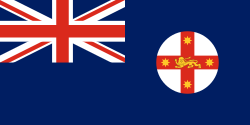| Colony of New South Wales | |||||||||||||||||||
|---|---|---|---|---|---|---|---|---|---|---|---|---|---|---|---|---|---|---|---|
| British Crown Colony | |||||||||||||||||||
| 1788–1901 | |||||||||||||||||||
 | |||||||||||||||||||
| Anthem | |||||||||||||||||||
| "God Save the King/Queen" | |||||||||||||||||||
| Government | |||||||||||||||||||
| • Type | Self-governing colony | ||||||||||||||||||
| Monarch | |||||||||||||||||||
• 1788–1820 | George III (first) | ||||||||||||||||||
• 1837–1901 | Victoria (last) | ||||||||||||||||||
| Governor | |||||||||||||||||||
• 1788–1792 | Arthur Phillip (first) | ||||||||||||||||||
• 1899–1901 | William Lygon, 7th Earl Beauchamp (last) | ||||||||||||||||||
| Legislature | Parliament of New South Wales | ||||||||||||||||||
| History | |||||||||||||||||||
• Established | 18 January 1788 | ||||||||||||||||||
• Separation of Van Diemen's Land | 3 December 1825 | ||||||||||||||||||
• Separation of South Australia | 28 December 1836 | ||||||||||||||||||
• Separation of New Zealand | 1 July 1841 | ||||||||||||||||||
• Separation of Victoria | 1 July 1851 | ||||||||||||||||||
• Separation of Queensland | 6 June 1859 | ||||||||||||||||||
• Separation of the Northern Territory | 6 July 1863 | ||||||||||||||||||
| 1 January 1901 | |||||||||||||||||||
| |||||||||||||||||||
| Today part of | |||||||||||||||||||
The Colony of New South Wales was a colony of the British Empire from 1788 to 1901, when it became a State of the Commonwealth of Australia. At its greatest extent, the colony of New South Wales included the present-day Australian states of New South Wales, Queensland, Victoria, Tasmania, and South Australia, the Northern Territory as well as New Zealand.
Contents
- History
- Formation
- Separation of Van Diemen's Land
- Separation of South Australia
- Separation of New Zealand
- Separation of Victoria
- Separation of Queensland
- Demographics
- Federation
- Australia Act
- See also
- References
The first responsible self-government of New South Wales was formed on 6 June 1856 with Sir Stuart Alexander Donaldson appointed by Governor Sir William Denison as its first Colonial Secretary. [1]


